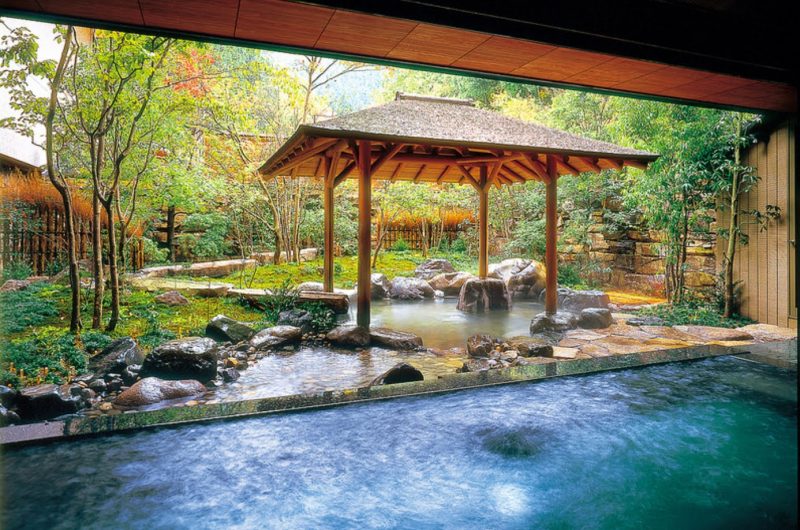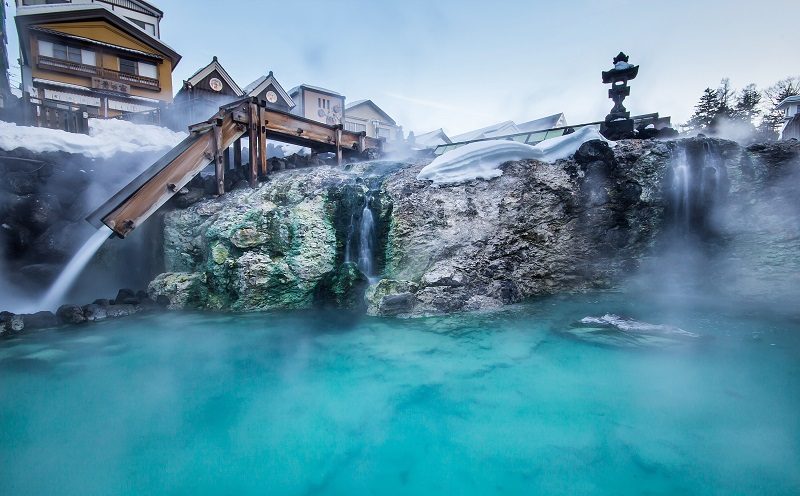The Japanese word onsen refers to the hot springs that dot the islands of Japan, fed by warm, mineral-rich spring water. Japan hosts a volcanic geography, so the water is heated naturally by geothermal forces. It bubbles forth from the ground, filling pools with water that is somewhat hotter than a standard Jacuzzi or hot tub.
Onsens are a popular attraction for Japanese tourists, due to both their cultural significance and their relaxing, recreational nature. Onsens play a significant role in Japanese culture, and they are used extensively by Japanese residents. It is thought that onsen have healing and rejuvenating qualities, helping conditions such as skin ailments and cancer.
There are onsen baths all around Japan, but before planning your trip, however, consider the following tips and information.
Types of onsen in Japan
The types of onsen available are as diverse as Japan itself. Some are located indoors, while others are open air. Some allow men and women to bathe together, while others have separate areas for each gender. Structures may include tile, stone, marble, iron, cypress, or cedar.
Many hotels and traditional Japanese inns, called ryokan, offer onsen services. In urban areas, modern bathhouses are available.
If you’re uncomfortable with public bathing, private onsen, or kashikiriburo, are available. Families or couples may reserve kazokuburo. Either type will provide you with increased privacy and a lock on the door. Some high-end luxury hotels offer onsen in your room.
Onsen etiquette
Japanese onsens always require nude bathing. This may be unnerving to some travelers, but following cultural etiquette will ease your transition into this uniquely Japanese experience.
Each onsen is equipped with a changing room. Here, you will remove all garments, including jewelry. You will be provided with baskets or lockers in which to place your belongings. Leave your cell phone and camera behind, as photography is not allowed.
- Don’t forget to bring your modesty towel. If using an onsen attached to your hotel or ryokan, a small modesty towel is usually available in your room. Bring it with you to the onsen. If using a public onsen, you will need to bring your own towel or purchase one at the reception area. Whenever you are out of the water, cover yourself with the modesty towel.
- You must always wash before entering an onsen. Showers will be available in or near the changing room. You may wash with or without soap. If using soap, be sure to rinse thoroughly so as to not get soap residue in the waters of the onsen. In very traditional onsen, the washing area may not include modern showers; in that case, you will crouch and scoop water from a basin to wash.
Inside the onsen
- When entering the onsen waters, move slowly and try not to splash. Do not swim around – onsen are for soaking. Do not get your modesty towel in the water, as this is considered rude. Also, do not wring water from your towel into the onsen. Place your towel either on your head or somewhere out of the water until you are ready to exit the onsen. Be careful of slippery, wet floors.
- Shower again after leaving the onsen. Be sure to leave the area as you found it – neat and clean. If you use a stool or seat to shower, return it to its place.
- Most onsen have separate bathing areas for men and women, but a few are mixed. If this is a concern, be sure to ask before entering. Some have hours assigned to each gender, so be attentive to your timing. Also, many onsen do not allow use by those with large tattoos, as in Japan this is often a symbol of mafia or Yakusa involvement. If you have small tattoos, you may cover them with a waterproof bandage. If you have a lot of ink, you may reserve a private onsen.
Best onsen in Japan
You can reach many traditional onsen using your Japan Rail Pass. The Kinosaki Onsen in Hyogo, for example, has a distinctly historic atmosphere. It has seven public onsen, or sotoyu, and locals and visitors alike can be seen walking in traditional cotton robes. Reach this onsen using your JR Pass by taking the Hikari train on the Tokaido Shinkansen line to Kyoto from Tokyo. In Kyoto, transfer to a limited express train to the Kinosaki Onsen Station. The trip takes five to six hours.

The Beppu Osen in Oita (Kyushu island) consists of eight hot spring areas. Situated between the mountains and the bay, these onsen offer views of the sea. From Tokyo, take the Tokaido or Sanyo Shinkansen to Kokura Station. You will transfer from the Hikari to the Sakura train at Shin-Osaka Station. From Kokura, transfer to the Sonic Limited Express train to Beppu. This trip takes around seven hours.
Hakone Onsen in Kanagawa is located only one hour from Tokyo. Take the Tokaido Shinkansen from Tokyo Station to Odawara. From there, you will have to use non-JR trains or buses to reach Hakone. Famous for its views of the majestic Mount Fuji, this onsen town has a long history spanning 1,200 years.
Finally, Kusatsu Onsen, in Gunma prefecture, is one of the most popular hot spring resorts in Japan. Located 1200 meters above the sea, it is also good for skiing during the winter and hiking the rest of the year.
Check out also our brand new guide about the 10 best onsen in Japan!
During your travels in Japan, you will likely find onsen wherever you are. Bathing in an onsen will help you relax both body and mind, so do not hesitate to try them!
